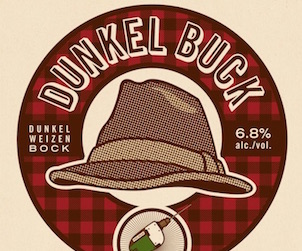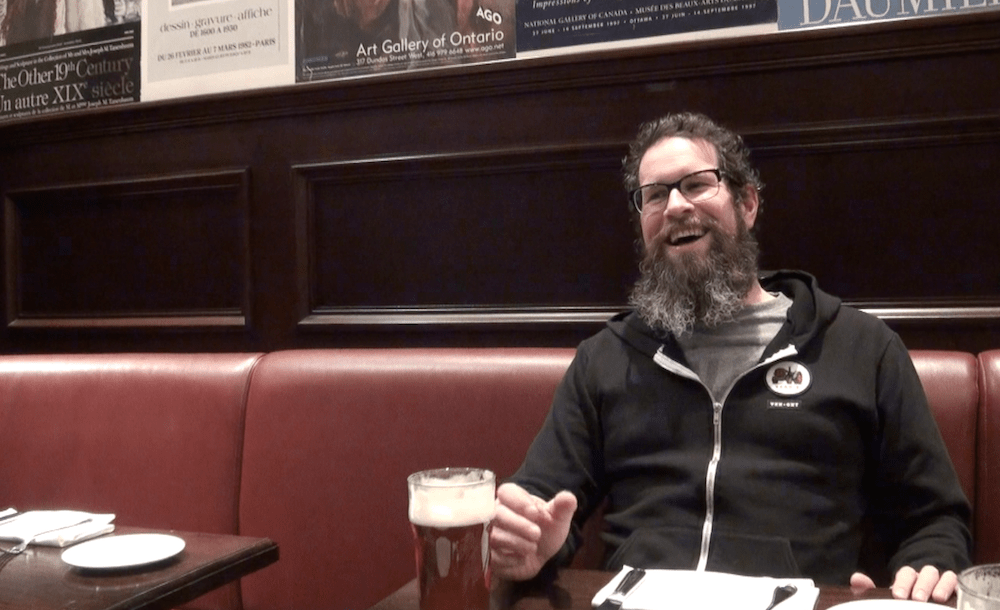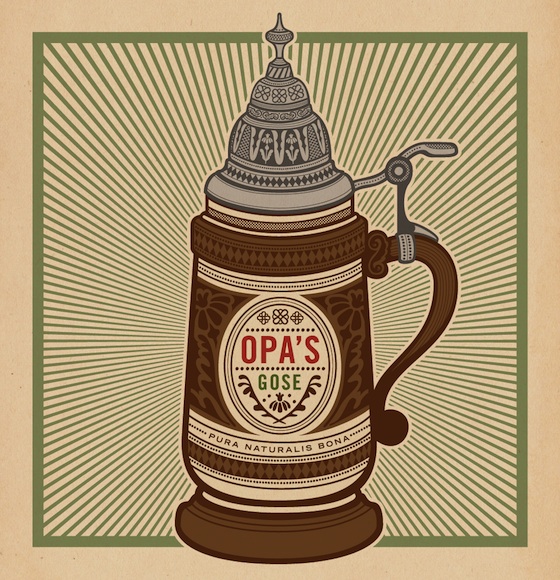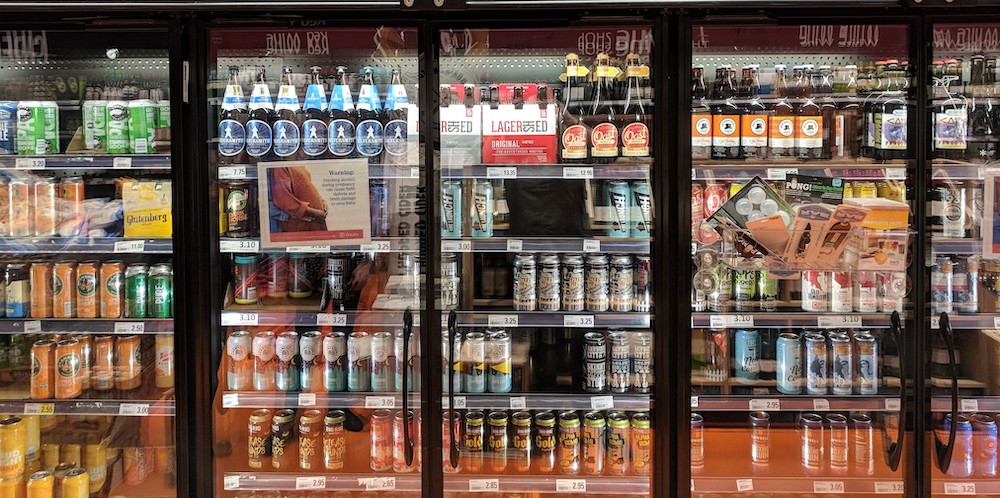by Niall Macpherson
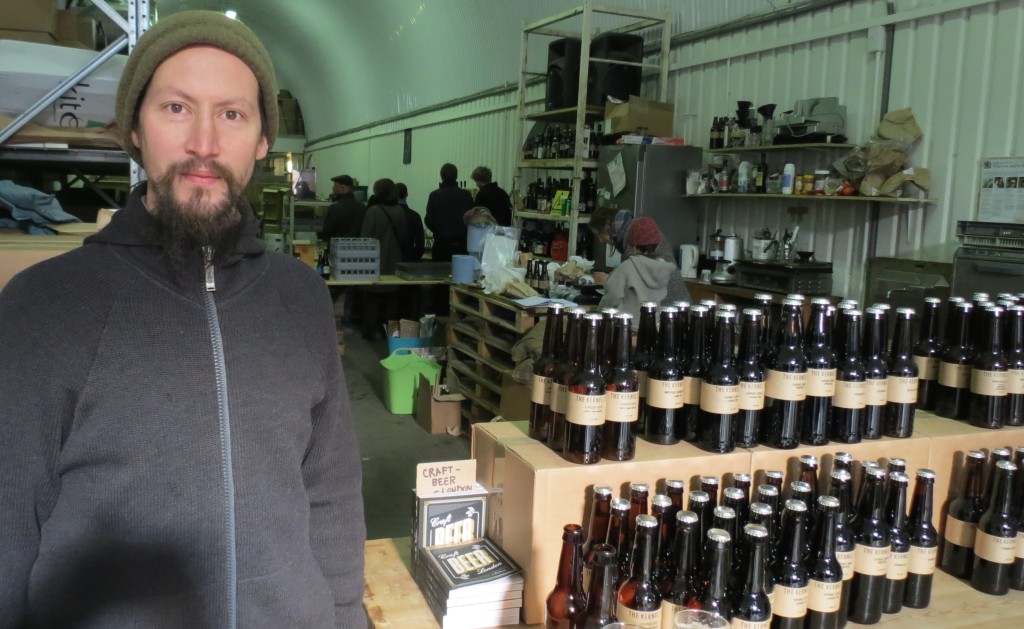
The Kernel Brewery has been at the forefront of the craft beer movement in the UK since opening in 2009. One of the first of a new wave of approximately 50 small breweries which have opened in London since the late noughties, they have led the way, setting a standard that few breweries can match. Many of their beers routinely top ‘best of…’ lists and the consistent quality of their output has seen them win numerous awards, and a legion of dedicated fans. I caught up with founder Evin O’Riordain to learn more about the brewery.
Good Food Revolution: Could you tell us a little bit about your background and how you started brewing?
Evin O’Riordain: We started in late 2009, so just over four years. We were on a different road to where we are now, about half a mile west of here, sharing with a couple of friends: one cheesemaker and one importer of ham and charcuterie. We had a 650 litre kit. We were there for two and a half years and we’ve been here not quite two. So here we have a bit more space, a three-thousand two-hundred litre system.
GFR: What led you to brew as a profession?
EO: At that point in my life I’d finished working at Neal’s Yard Dairy. I’d been selling cheese for the last ten years before I started this. At that point I’d finished working for Neal’s Yard. I’d been there for about seven years and I had my own cheese stall in Borough Market, selling Caerphilly, but Neal’s Yard needed someone to go over to the States for a couple of months to help one of the American customers set up a cheese shop over there. So they asked me to go over as I knew everything but I wasn’t working for them at the time, so they sent me over there for a couple of months to help Wholefoods open up a cheese shop in the Lower East Side of Manhattan. And that’s where I discovered beer, or beer as I now think of it rather than beer as I knew it before, or didn’t know as the case may be.
So, I’d teach all these guys about cheese – where it’s from, the name of the farmer that makes it, the name of the cheesemaker, the milk it’s from, what are the historical traditions behind this kind of style or recipe, what makes it different from the other one down the road, what the animals are eating and how that affects the milk and what it will taste like, and how to look after it – all that sort of stuff.
We’d go out for a drink afterwards with all the guys I was working with, there’d be this beer bar round the corner, we’d go through them all and they’d tell me all this information that I’d just told them about cheese, but about beer. So immediately I understood it completely without having a single clue what they were talking about. I wasn’t quite ‘what’s a hop?’ but I wasn’t far off. So they were treating their beer with the same respect as I was treating my cheese and all the beer I had ever drunk over here was given no respect as far as I could tell.
We would have been drinking real ale when we went out to drink – we’d have made the choice not to drink mass produced lager but that’s as far as it went. Real ale was a thing – it didn’t matter who made it, it didn’t matter what was in it, it was just like ‘you drink real ale, that’s fine’ and that was enough. Whereas the Americans were celebrating things in a more intense, enthusiastic manner. They were grasping things in a way that wasn’t happening here as far as I could see.
GFR: Were there any particular East Coast breweries that you were drinking at that time which stand out?
EO: There was a moment – I was waiting for someone in a beer garden at a place called D.B.A’s which was just around the corner from that Wholefood shop on the Lower East Side of Manhattan. I don’t remember what I was drinking, but I remember going ‘woah!, why isn’t that happening back in London’ and then going ‘oh, well, maybe it should’. Some of the breweries that were quite influential, I suppose, were not at that particular moment, but…
Storywise for example, Dogfish Head were doing things like digging up pottery, scraping of the inside of shards, analysing what was in there and trying to recreate something. There’s a couple of beers I still haven’t tried today that follow that method in terms of the story and in terms of thinking about it, or the way of thinking about it. It’s quite fascinating.
And there was a particular place called Fette Sau, a BBQ place in Brooklyn. They are a sister to what was at that point in time Ratebeer’s best beer bar in the world called Spuyten Duyvil, but this place just served, not ‘just served’, southern BBQ or their interpretation of it – you order things by weight. But they have a very well curated beer list, it’s not insane, it’s just well looked after and tight. And there was a couple of beers there that they had brewed themselves – a house beer – there were a couple of those that were just mind-blowing. And that place, there was so much joy in a place like this.
GFR: When you opened there wasn’t a massive amount of beer available from smaller London breweries.
EO: It’s not that, it wasn’t the smallness of the breweries it was more the style of beer I think. Partly why that sort of epiphany happened was because I wasn’t as aware of beer here as I could have been. Coming from the background I did I’m still surprised by that. Pretty much all forms of food, we’d have known everything to drink with it. Beer was something we drank a hell of a lot of, but in terms of thinking about it, not at all.
It’s not helped by a few… I don’t know what you’d call them, traditions? Quirks of British drinking? I mean one is the pub – I love pubs, I think they’re great but in a sense because they lend themselves to a cosy familiarity…
GFR: Then people aren’t taking chances as much?
EO: You go to a pub to enjoy it and have a good time with your friends and the beer is a secondary thing. I think beer should always be there to serve a social occasion but I don’t think there was as much attention to the beer as there could have been. And the pubs that did focus on beer, real ale for example – in those days there was a couple of good ones we used to drink at quite a lot, say The Market Porter in Borough Market because I used to work just across the road.
They’d have twelve hand pumps or something but they were never – and my experience isn’t much beyond this, it doesn’t cover all the pubs in London – but it was never very engaging in terms of what was on. Often you’d find twelve beers on and realize there were twelve of the same kind, and even more infuriating – if there was one that was really nice, say something pale and hoppy that appears out of nowhere and you’re like ‘that was brilliant, can I have some more?’ then you realize that everyone has drunk that too because it was so good and then you ask ‘are you going to get some more in tomorrow?’ and they go ‘no, we just change everything all the time so that people can have something new to drink’.
I don’t necessarily want new, I just want ‘good’, why can’t you put that on all the time. But no, the mentality of changing things, which still exists even in our sort of world now, that whole idea of novelty and innovation, shall we say, that was a huge force I think at play. But there was a certain British mentality of real ale being associated with a ticking mentality of trying new things all the time and people weren’t curating their beers in order to be selecting the best ones.
GFR: Given the environment when you started making your own beer, which was different to the norm, or different to what was most commonly available…
EO: Yeah, exactly. There were definitely other breweries around doing similar things and certainly lots of beers that I’ve discovered since that I would have really loved drinking at the time. Part of it is to do with the way the pubs worked I suppose, and you know, I’ve lived in London for fifteen years, I’ve never lived anywhere else in the country so I don’t really know what was happening elsewhere. But there were pockets of a stronger tradition of various different things. I mean Yorkshire’s always been quite strong in terms of its Yorkshire bitters and they can often have been pale and hoppy, much more so than beers that would have been around down in this part of the country.
And there were breweries up there, like Roosters in Yorkshire, who in the 90s starting brewing things with Cascade. I don’t know if they never came down here, or if they came down here you couldn’t find it. Also, how would you find out? I suppose these days there’s things like social media which enables you to find things out in a way you couldn’t before. Unless someone advertises a festival and says they are going to have this in printed in a leaflet you wouldn’t know. Obviously, nobody thinks that way any more because we all have phones that tell you these things.
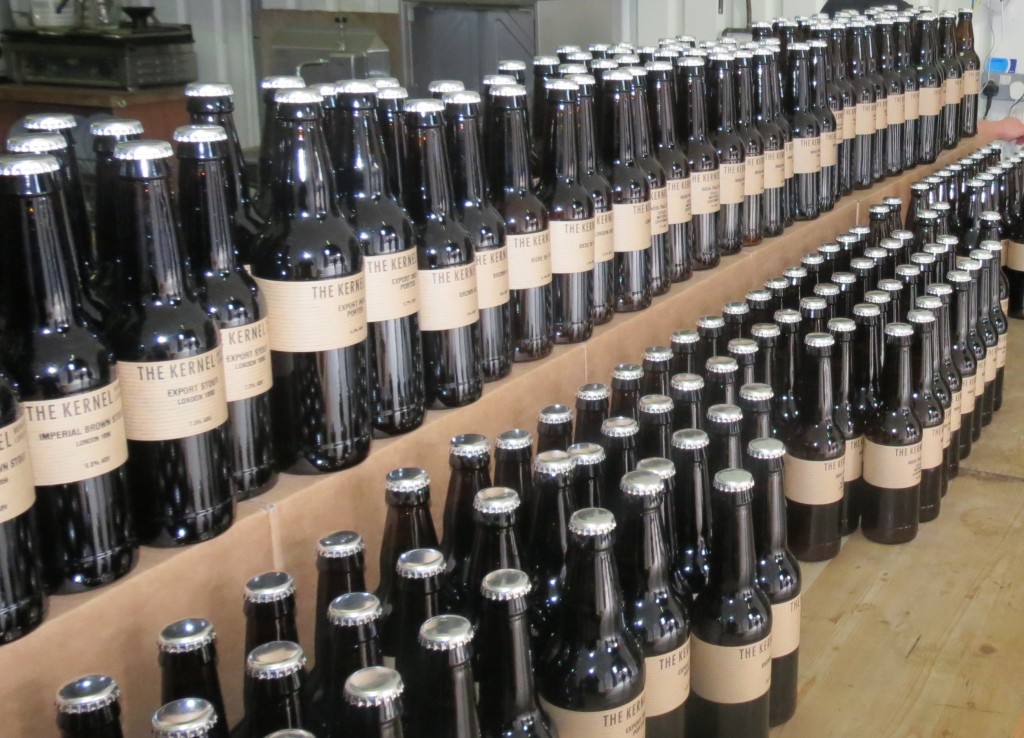
GFR: How difficult was it to have your beers recognized and in the marketplace? What challenges did you have at that time in terms of peoples’ pre-existing opinions of what would sell, or beer-drinkers’ expectations?
EO: Yeah, I mean as I said there were a couple of other breweries that I respect a lot that were already doing stuff – Thornbridge had been a round for a few years, Dark Star, people like Marble, Roosters… There’s probably a few more that I can’t think of off the top of my head. When I came back from the States, that trip was March, April, May 2007. I came back and was looking around and digging through the internet. I turned up these two guys called BrewDog who had started this brewery in Scotland and from what they said, and they had a very different way of speaking and presenting themselves than I would necessarily follow, but I knew exactly what they were talking about and I understood them completely and then I got hold of some Punk IPA and went ‘that’s the stuff’, so already it’s not like I felt I was completely on my own.
These guys were trying to do it from up there – complete nutters – and Punk IPA in those days, that was it. I mean not ‘that was it’ but that’s all you needed, it was someone else who was doing the same thing, they had the same ideas and they were making beer that was stunning. And I still regret the fact that they changed the recipe, but that’s OK. But the first edition was just uncompromising.
And the other thing it taught me was when I came back and was looking for all these American beers that I’d tried, or whatever I could find because obviously there wasn’t that much available. Working in Borough Market I could go to Utobeer. They have this big stall with quite a large selection and you’d find one and think ‘oh, I tried some of that, lovely, Brooklyn’ and you’d drink it and go ‘that’s doesn’t quite taste…’ you know? And it takes a while for the penny to drop and you realize that it’s taken it months to get here, it’s sat in a warehouse there for a bit, someone’s sold it to me now, it’s a long way from home and it’s pretty tired.
And that was the other thing – you have the realization that beer should be fresh. I suppose if you start off with a certain inspiration you kind of fear an influence from there, or a competition, whatever… but then when you realize that all the American beers that are amazing, they don’t taste the same. I mean some stouts can travel and they can taste perfectly fine but if you are interested in something pale and hoppy, it has to be local or, at least, get here within a very small space of time which I don’t think is the case for pretty much anything American. That at least made things seem slightly feasible.
In terms of challenges, you know, either we were lucky, or we were prescient or we had no idea what we were doing. There was a certain kind of ‘right place, right time’ mentality. Now I still think we’ve done everything properly, which I think is very important and I think we make really good beers, which is very important, but I also think we were able to do both of those things at a certain time.
My experience in the States is nothing unique, nothing at all, so many people living in London have the experience of going to other cities, finding something amazing and a certain part of the culture and they’ve come back and said ‘where is it?’ And you can see how it’s affected food, the growth of, say farmers markets, people’s attention to cheese, for example. You see it in coffee, so you have a massive influence from Australia and New Zealand and people started opening cafes and suddenly London’s awash with people who are really obsessed by coffee and there are some fucking amazing coffees, which is a very good thing.
Anyone hanging around in the States with some American friends would have been introduced, if they were, you know, the sort of person who probably lives in Shoreditch, or Hackney or around here, people like me… They were already there.
GFR: There were already people looking for what you were able to provide?
EO: Yeah, I didn’t start out with a business plan as such, or a particular model, it was just ‘if I can make beers that are really good, people will buy them’. From working in Neal’s Yard the emphasis was always on how something tasted. That was the most important thing and, in a sense, you don’t have to have a sales patter, or a speech, you just go ‘try this, what do you think?’
GFR: And it sells itself?
EO: Yes, or you give people a taste of a few different cheddars and they have to think about it, but then they’ll go ‘I’ll have that one, thanks’. We look after what we do as much as we can and as long as we think what we make is really good then it doesn’t matter who you are and what your tastes are, you should be able to recognize that fact. So it’s a bout having a little bit of faith. It was pretty slow, I suppose, in the beginning. It took us a while to get going but I also don’t like, say, cold calling people so I didn’t. I didn’t go out and make any calls to anybody to try and sell beer – it probably would have sped things up if I had.
GFR: So, how did people tend to find out about it?
EO: Friends. Neal’s Yard, I suppose, specifically. Because our original brewery was just next door to their arches, and having worked there for so long, and they supply all the best delis and all the best restaurants in town. We opened in November and, I think, the first Christmas, they bought fifty cases or something and sent a couple of bottles to all their customers as a Christmas present. And the ones that were interested are probably still selling it now. So, just word of mouth and recommendations.
It started slowly but I think you generate a stronger relationship with people through that route rather than forcing yourself upon them. If people come to you they’ve put an effort in. It means a lot to them because they’ve checked out the other possibilities and they’ve come to visit us and check out what we do.
GFR: Was there a point when you looked around and thought hang-on, it’s not just me anymore?
EO: Again, it wasn’t just us starting at that time. Although, not coming from a brewing background it’s quite odd…I knew nothing about pubs, apart from drinking in them, and I knew nothing about selling to pubs which wasn’t that important because we mainly did bottles. And not having worked in any other breweries, and not having had any formal training I found it a little bit scary.
April, the year after we started, we got together and founded the London Brewers’ Alliance. The impulse came from a gentleman called Phil Lowry, who’s actually from outside of this field, but it was his inspiration to try it and he did all the work – I think I was just the first person he talked to. I think in April there was nine of us. Of the breweries around, I think Sambrooks had been around since 2008, so they were one of the first stand-alone breweries for a long time. Meantime had been around, they’ve been around for just over ten years now, Youngs had just left in 2007 and there were six or seven brew-pubs I think, or five or six – Brew Wharf, The Florence, Zero Degrees, and a couple more, but they are all not around anymore – there was a couple in the centre of town. Meantime, Fullers, Sambrooks were all there from before and there was about five or six of us that had just started, so Redemption started in January of 2010, Camden a couple of months later – they’d already been brewing as a brewpub but the proper Camden brewery was commissioned that spring – Windsor and Eton started that spring, who else? Brodies.
So, you have a small group of people to talk to and share ideas with and get technical help. Having people like Fullers around is just invaluable, collectively John (Keeling) and Derek (Prentice) have 80 years of actual brewing experience between them and then they’ve got the entire history of their company. There’s probably not too much those guys don’t know, although they still don’t really get on with American hops, but that’s fine. It’s a positive thing to find other people – when there were nine or ten, or fifteen, that’s a manageable number.
Now that there’s 60-odd it’s really difficult because we don’t want to have any formal structure, there are some rules, but if you’re brewing in London you’re welcome to be a member, basically. You can’t kick anybody out, well, nobody’s tried. Nobody’s been kicked out. I love that principle but then at the same time it means that you have some people and you’re just kind of going ‘oh why….’ either because they talk too much or they waste time in meetings, or they are making beer that you think isn’t good for the reputation of London beers.
Even still I think it’s generally healthy. There’s a lot of breweries making very good beer, and a lot of breweries making better beer than I think they would otherwise through help from friends, having a neighbor who’s making beer that they are working towards.
But there are always, and it’s inevitable, that there are people who aren’t quite in it for the right reasons. In the sense that they feel that there is a bandwagon to be jumped on. It’s about just being cool, it’s a lifestyle thing or whatever people think about brewing. And, yeah, there’s some people brewing beer which I don’t think is quite up to scratch. Because if you want to associate London beer with something then it’s also got to do with your beer: if one beer is judged as a London beer and my beer is judged as a London beer and I don’t want people to have a bad experience with a beer they might associate with all the rest of us.
GFR: If there had been 60-odd breweries in London when you started, would you still have started?
I’m bad at answering what-if questions. My imagination is poor… I don’t know, I really don’t know. It would have been easier and more difficult.
GFR: The easier side would be?
EO: Our neighbours here, so there is Brew By Numbers, especially Brew By Numbers and Partizan. And we’ve known them pretty closely, and for a long time before they opened, just through talking to them and stuff. For example, I know how much beer had been asked of them before they even opened. We didn’t have that – we drank our whole first batch ourselves, which was our choice but we didn’t actually tell anybody we were there, which was also our choice.
I’m not saying it would have been any different, but because of the interest in London beer and the growth in places that want good, local beer and people are on the look-out for new breweries because this is what’s happening at this point in time. You can much more comfortably get up to a financial speed I think, so in that sense it’s easier. But in the other sense I suppose you have 60 other breweries.. London can still handle that especially since most of the breweries are very small. So although the number is large the physical quantity of beer being produced it actually fairly low.
Fuller’s produce more than all the craft breweries in this country times fifteen or whatever it might be, and they’re not a big brewery in the international sense. Meantime, compared to any of the rest of us, are massive. And then you have Brew By Numbers who started as a commercial brewery with a 50 litre/60 litre kit – so you can call yourself an official brewery. Anspach and Hobday have something similar, you’ve got guys called Bullfinch brewing in there with them. So it’s a physical brewery and they make beer, and I’m not judging their beer in any way, shape or form, but in terms of the volume of beer you can produce it doesn’t affect the overall numbers. If you have 60 breweries Meantime size it’s a different equation.
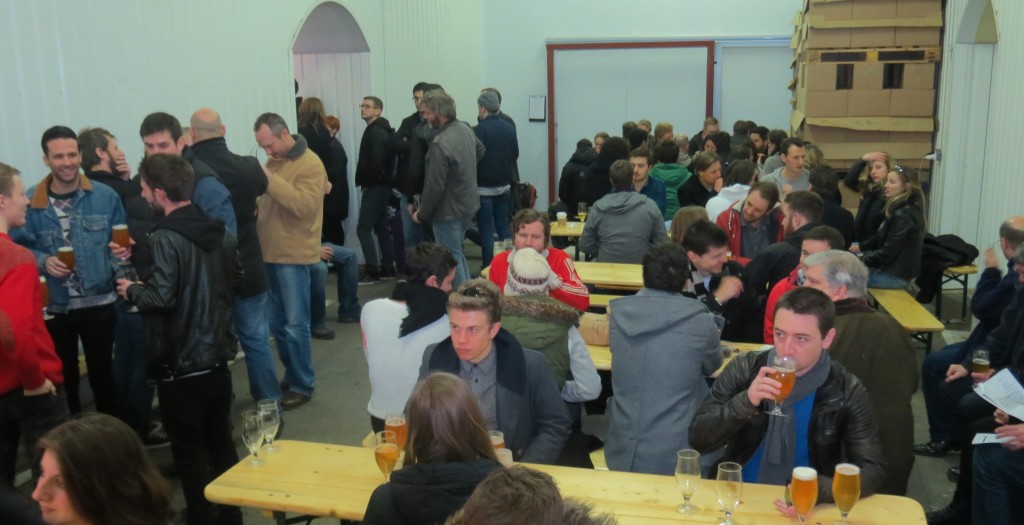
GFR: One of the things that makes you stand out in comparison to the other breweries is the variety of beers you’ve put out in terms of using different hop combinations. I don’t know how many different beers you’ve put out but it must be in the 200’s (277 currently).
EO: You’re not far off according to RateBeer – that’s the only statistic we have. We pretty much consider every time we brew to be different. That’s one of the things… I didn’t have any professional experience or training, so when you start brewing on a new kit… Well, first you’ve got to learn that and then you’ve also got all these ingredients. Home brewers here, in this country, don’t seem to have as much access to as many different hops, for example, as commercial brewer. So we had a lot of stuff to play with – so you’ve got Chinook, Cascade, Centennial, Columbus and you say ‘what will I do?’ Try one of each.
So we learnt something and then we starting blending combinations and then, I suppose after a year, we started getting the next season’s crop in. And then you use them and you suddenly realise, and again it’s one of those things that takes a while for you to realize…‘they don’t taste the same as they did last year, and then you go ‘of course, it’s completely obvious’ it’s a plant, it grows…
GFR: …the soil, the weather?
EO: …was there sunshine, exactly. It’s a different farm, it was grown down the road etc. OK, so then you do what you did last year again to find out what they are like this year and by the time you’ve finished that process and learnt everything, you’ve used up all your hops for that year and it’s the next year and you start again. It has kind of evolved into something of a modus operandi but it still is very much about learning what we can and trying to get the ingredients to express themselves rather than us impose some sort of expected consistency of them.
I think if we wanted to make a ‘Kernel Pale Ale’ then we would be trying to get ingredients to replicate a flavor that we already had in our heads and I think the way that we brew is slightly more open in the sense that we take the ingredients and in a sense try and let them express themselves within the general framework of tastes we like. So, in the one sense, one of our pale ales is a different beer each time, this one here’s Chinook, that one’s Centennial, that one’s Polaris, that one’s Citra… There’s a lot of single hops around this time of year because we usually get our fresh season hops at the beginning of January, so all of the beers we’ve done in the last few weeks have been single hops to see how the hops are this year.
In one sense they are all different but in the other sense it’s a Kernel pale ale and we like that kind of ambiguity. Some people will go in and say ‘can I have a Kernel Pale Ale please’ and someone will go in and say ‘which Kernel Pale Ale do you have?’ It wasn’t a willful thing but that’s the way it ended up. But it also expresses quite well that brewing is a batch process, every batch will be different, technically it’s hugely different, you never do the same thing twice. If you’re a mass lager producer you have my upmost respect because you get things to taste exactly the same, or nothing, for infinity. A, we have no interest in that, B, we couldn’t do it anyway, but we can pretty much do a pale ale to the same recipe, change the hops. It will be slightly different but it will still taste of one of our beers, I think, as long as the quality is consistent.
GFR: And I think that is the remarkable thing, with so many beers out there the quality is so consistent.
EO: We care, we’re not going to release anything we don’t think is great. There are some hops, for example, that give off flavours which are sometimes not to somebody’s taste. Like some of the Australian hops, like Galaxy, have a really raucous bitterness which I don’t mind but there’s a couple of guys here who just find it too much. And there’s a hop called Soraci Ace which comes across like dill, lemon, washing up liquid, it’s horrible!
There are people who think it’s the best thing ever. You know, it’s fine. We’ve never used that one. There are a few others that we’ve got that we’ve never tried before so you try them out. We used one called Waimea which had a similar herbal trait and some people really liked it. Someone was in here yesterday and said ‘that Waimea was the most…’ and I think that person really enjoyed it because it was the most memorable of our beers, and I think memorable…
GFR: Isn’t always a good thing?
EO: It could be memorable for the wrong reasons. We allow ourselves a little bit of scope and although there are a few hundred different beers there are really… I mean we do the table beer, the pale ale and the IPA are pretty much the same concept and they are the same, not quite the same, base beer but they are pale, straightforward and hoppy. The export stout and the brown stout again are similar things on a scale, so in a sense you could say we do pale beer, dark beer and sour beer and that’s us covered. There’s a lot more – Belgian styles we don’t do too much of, or German styles, they’re mostly not to our taste.
GFR: One of the things that is interesting to me is that your philosophy doesn’t seem to have changed from day one in some respects, whether it’s letting the beer speak for itself, or the minimal branding. I was wondering if there was ever any temptation to do anything but let the beer speak for itself?
EO: I think it means a lot that you’ve picked that up. It is something that’s important to us. No, no. It’s also very difficult to change something once you have it. So rebranding or whatever, if you want to do that would be a major pain. And the question of why you would want to… I haven’t really thought about it at all. Not in terms of labels, image or the way we work I suppose, I don’t think any of that needs changing. I think maybe there are some things we could do better, I’m talking about different situations, you know?
Being able to, say, work more closely with the people who are selling our beer, for example. Make more of an effort to get people down, making sure they feel they can calls us. I don’t know enough, I suppose, about what happens to our beer when it goes out. And also on Saturdays here we open up and, it’s not really a problem I suppose, in one sense. Since Brew by Numbers opened, and Anspach and Hobday, and that’s pretty much in the last few months, though Brew by Numbers were around before but they only started brewing in November so its only really been since January. Before that it was pretty much OK in here but since then we’ve been really, really busy.
So having that density of breweries down here has attracted more people down which in one sense is good, in another sense it defeats the purpose of what we were trying to do, what we did before which is, you know, I’m down here every Saturday, all the guys here are down, so all the brewers, they know everything about what’s going on so if you want to come in and buy some beer and ask some questions you have the people in front of you.
If you just want to buy a beer or have a glass you can do that too, but we want to be here, also to get feedback from people. The thing is once it gets a bit too busy and I’m there just pouring beer all day it misses its purpose some how. It would be nicer to be able to give people more time when they make the effort to come down here. That’s something we want to try and work on. It was working pretty well but it’s just got a little bit busy for that.
GFR: A victim of your own success?
EO: Yeah, well, you know, it just isn’t what we wanted it to be. It’s like what we were saying – we make beers that we enjoy drinking and we’d like this to be a space were we would enjoy drinking but it’s a place we probably wouldn’t come [to] because it’s too busy. We’re grumpy old men, you know, we’re not really into this. But it’s just a bit too much, you know?
The excitement and enthusiasm about beer is great but it sometimes gets to a fever pitch of excitement which I don’t think…you know, being told that this certain beer is being launched at this place and it’s the most exciting thing ever, and everyone goes down and gets really excited and goes mental. I think I’d much rather go home. Some of those festivals I find the same, you can leave a festival having spent all day there and tried lots of beers, but all I want to do is go to the pub.
GFR: Have a few nice pints?
EO: It refreshes parts that festivals don’t reach. And this has become… it doesn’t quite feel like the place you would relax in.
GFR: Just to finish off, we’ve talked about the past and the present, I was wondering how you felt things might develop in London, whether it will reach a saturation point with so many new breweries opening every month? What are your thoughts.
EO: Like I said before, I don’t think the numbers are much of an issue. I suppose if there’s a certain part of the market that is driven by novelty, new breweries etc. There’s a certain initial attraction with new breweries because you haven’t tried their beer – you could be the first person to have this, or your customers are going to come in and say ‘oh, what’s that?’ It generates its own momentum and a little bit of buzz. And it doesn’t seem like it’s abating anytime soon.
I can think of about four or five breweries opening in the next few months who have gone in on a large scale. Most of the ones who have opened up ‘til now have started off pretty small, so like a five barrel, eight barrel, like Redchurch or East London, or London Fields. But then there are three or four more that are opening up with fifteen, twenty, thirty barrel systems and Fourpure started just recently with a large system – twenty barrels as well. That’s going to change things a bit more I think, but there is still plenty of space in London for all this. Obviously, alongside the breweries there’s been a huge change in the places you can drink beer.
There’s been traditional pubs, which are still traditional which have embraced keg beers or whatever, and there’s been a lot of new places that have opened up. So when we started five years ago there wasn’t too much. The Rake had been around for a little while and The White Horse on Parson’s Green but since then the amount of places that are purely focused on, shall we say, craft beer, for want of a better word, is huge. And the amount of places that wouldn’t call themselves that but at least want to have some good beer because its local, or they think its trendy, or they enjoy it for other reasons, it’s growing even faster and the thing is it’s nowhere near saturation in that sense.
One of those things of spending time in Brooklyn, for example, is that every place that pours beer has Brooklyn lagers. It’s the most boring beer there because its so ubiquitous but at the same time if you’re somewhere where every other beer is absolute shit you can at least get something to drink that’s pretty good. It’s good. That’s still a ways away and the thing is I don’t feel people go backwards from that. I’,m not saying having one brand everywhere, I’m talking about London beers, at least good beer. And once people make that choice to drink good beer I don’t think they go back. It does depend on the beers that people make, on the brewers behavior…
GFR: Attention to detail?
EO: Yeah, yeah, because there are some that are whipping up the crowd into a frenzy of excitement and madness but I think that’s short termist. I don’t think that sort of enthusiasm, that’s not what’s going to carry people for twenty years. That’s like a romantic fling: its beautiful and intense but I don’t think its got the longest of legs, and it can also be pretty tiring to put yourself through that whole routine of being, whatever, circus master or showman. You’re just thinking of all these new beers and trying to find new ways of being crazy and cool – what’s the next gimmick that we want to bring people in on. But there’s plenty more space in London.
…
 Niall Macpherson is a media professional, beer enthusiast and home brewer living in London, UK.
Niall Macpherson is a media professional, beer enthusiast and home brewer living in London, UK.



